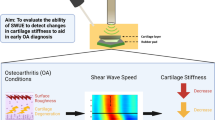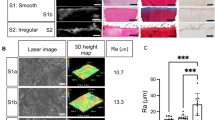Abstract.
We studied the correlation between histological imaging quantification and the biochemical assessment of proteoglycan (PG) content in articular cartilage in vitro, which served as a basis for the validation of ultrasound detection as a noninvasive tool in the assessment of PG changes in full-thickness articular cartilage. Articular cartilage of 14 intact fresh bovine femoral condyles was used for trypsin digestion. Full-thickness articular cartilage cylinders, 3 mm in diameter, were harvested at time intervals of 0.5, 1, 2, and 3 h after trypsin digestion. Each cartilage cylinder was then cut into two equal parts for either histomorphometric quantification of the PG area fraction stained with Safranine O or conventional biochemical assessment of uronic acid content. In addition, five fresh mature bovine patellae were used for the validation of an ultrasound compression system developed for testing the potential layered biomechanical properties of articular cartilage, including the equilibrium compressive modulus, i.e., the slope of the linear regression of the equilibrium stress-strain curve. Results showed that PG content in the articular cartilage was significantly decreased with increasing time of trypsin digestion, both histologically and biochemically, with a significant correlation of r= 0.502 (P < 0.001). Ultrasound measurements demonstrated differences in the equilibrium compressive moduli of the digested zone, the undigested zone, and the entire articular cartilage layer, as well as a characteristically large ultrasound reflection signal detected in the interface of the trypsin digestion front of articu-lar cartilage. The results of this study suggested that the histomorphometric quantification of PG content could be used to reflect not only PG quantity but also its spatial distribution; also, the ultrasound compression system might have potential for the non-invasive detection of pathological changes in articular cartilage.
Similar content being viewed by others
Author information
Authors and Affiliations
Additional information
Received: October 14, 2000 / Accepted: February 8, 2002
About this article
Cite this article
Qin, L., Zheng, Y., Leung, C. et al. Ultrasound detection of trypsin-treated articular cartilage: its association with cartilaginous proteoglycans assessed by histological and biochemical methods. J Bone Miner Metab 20, 281–287 (2002). https://doi.org/10.1007/s007740200040
Issue Date:
DOI: https://doi.org/10.1007/s007740200040




